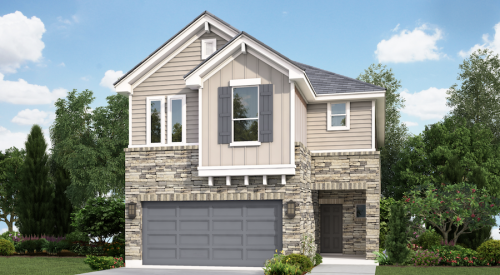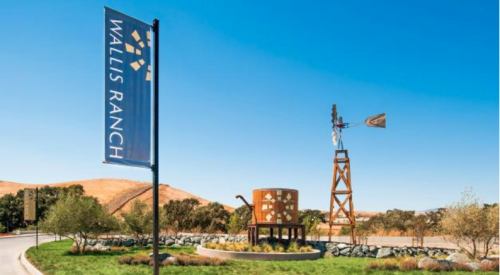Just for a moment, shut out the gloomy picture being painted of our nation's housing market, because it's not the same everywhere. We found five markets where a combination of factors, including job growth, population growth and a brisk pace of economic development, bode well for housing in the long term.
In no particular order, the chosen cities are Huntsville, Ala.; Beaumont-Port Arthur, Texas; Allentown-Bethlehem-Easton, Pa.-N.J.; Salt Lake City; and the New Orleans area. One thing they all have in common is a small housing bubble (or, in the case of Huntsville, no bubble). That's according to John Burns Real Estate Consulting, which assigns a Housing Market Barometer to metro areas across the United States. This measurement is a calculation of inventory and affordability — in other words, the size of the bubble.
Will Beaumont-Port Arthur become the next Houston? Will Huntsville grow to the size of Nashville or Atlanta? Probably not. Builders in those smaller markets are doing a better job of controlling growth. And even during the worst housing bust in years, there are bright spots.
 |
|
The oil eruption of Spindletop in 1901 spawned much of the real-estate development in Port Arthur, Beaumont and Orange, Texas, also known as the Golden Triangle. |
Beaumont-Port Arthur, Texas
For the first time in years, the Gulf Coast metro area of Beaumont-Port Arthur is poised for growth.
Locals often refer to this area as the Golden Triangle because it encompasses the neighboring city of Orange and many smaller communities in between. In 1901, the oil eruption of Port Arthur's Spindletop kicked off real-estate development and put Texas on the map as a top oil-producing state. The economy of the Golden Triangle has historically remained stable due to its ports, waterways and strong petrochemical industry, and today it's gearing up for more than $20 billion worth of refinery expansions and new industrial projects. In October 2007, the Southeast Texas Workforce Development Board estimated that 25,000 new workers would be needed between 2008 and 2011.
Local home builders are cautiously optimistic. "These industrial expansions take a long time," says Howard Nichols, managing partner of the Nichols Co. in Beaumont. "Most of the people who are going to be here at first will be temporary workers."
Nichols has been building in Beaumont for 35 years and currently has semi-custom spec homes ranging from $250,000 to $400,000. The pace of residential construction in Beaumont-Port Arthur has been consistent: 400 to 500 single-family homes a year for the last eight years, he says. "Our area does have a prospect for steady activity. We've never had a major slowdown because we don't overbuild."
Beaumont builder/developer Richard Guseman says, "There's been somewhat of a slowdown, but not to the same extent as other parts of the U.S. It's not like Nevada or Arizona or Florida with their 25-percent-a-year price increases." Guseman builds homes priced from the mid-$200,000s to $750,000-plus.
Joel Foxworth, vice president and senior business relationship manager with Wells Fargo Bank in Beaumont, says most builders in the Golden Triangle produce about 10 houses a year. But things could change.
"Right now we're experiencing a tremendous boom in hotels, apartment complexes, RV parks and temporary housing," says Foxworth. "The Workforce Development Board estimates that about one-third of the temporary workers will stay after the projects are complete. It's the permanent jobs afterward that are going to create housing demand."
FAST FACTS: BEAUMONT-PORT ARTHUR, TEXAS
POPULATION: 387,369
JOB GROWTH RATE: 2.0%
12-MONTH SINGLE-FAMILY PERMITS: 587
12-MONTH TOTAL PERMITS: 1,782
MEDIAN HOME PRICE: $134,300
NEAREST MAJOR CITY: Houston (90 miles west)
PRIMARY INDUSTRIES: Petrochemical manufacturing; petroleum refining
Sources: MetroStudy; John Burns Real Estate Consulting; Beaumont Convention & Visitors Bureau; Port Arthur Chamber of Commerce
 |
Salt Lake City
Salt Lake City is in a housing slump right now. "But when the light turns green, there's going to be squealing of tires," predicts Curtis Dowdle, executive officer with the Salt Lake Home Builders Association.
Brad Wilson of Destination Homes thinks Salt Lake City will rebound in early 2009. "We have a very strong economy and one of the lowest unemployment rates in the United States," says Wilson. "A lot of companies are relocating here. For the long term, we're bullish."
Salt Lake City trails the national market by 12 to 18 months and didn't begin to experience a slowdown until 2007, says Eric Allen, director of the Utah/Idaho division of MetroStudy, a housing research firm. However, he thinks prospects for a quick recovery are good. "Our housing inventory has always been very low," says Allen. "We're not a spec market."
Salt Lake City's construction sector accounts for approximately 25 percent of its job growth. Commercial construction is at a record level and absorbed many workers who were sidelined by the residential slowdown. Other job sectors, including business services and education services, are also healthy, says Allen: "We're creating 40,000 jobs a year just in the greater Salt Lake market."
Single-family attached housing has picked up in the last few years because it's more affordable than detached — under $220,000, says Allen. Some of that product is being built downtown, where redevelopment projects continue at a steady pace.
Allen forecasts approximately 7,000 single-family starts in 2008. They'll slowly begin to increase in early 2009.
Utah's birth rate is almost double the national average, so there are many large families. According to a University of Utah study, 30,000 new households will be created in 2008. Yet the fastest-growing demographic in the Wasatch Front (the three-county area in which most of the city's population resides) is 60- to 69-year-olds. "We have a kind of mecca mentality," says Dowdle. "Members of the Church of Jesus Christ of Latter-day Saints like to retire in Salt Lake City after living and working elsewhere."
FAST FACTS: SALT LAKE CITY
POPULATION: 1,055,059
JOB GROWTH RATE: 4.3%
12-MONTH SINGLE-FAMILY PERMITS: 3,935
12-MONTH TOTAL PERMITS: 6,122
MEDIAN HOME PRICE: $226,473
PRIMARY INDUSTRIES: Computer services; health care services; banking
Sources: MetroStudy; John Burns Real Estate Consulting; city-data.com
|
|
|
|
 |
Allentown-Bethlehem-Easton, Pa.-N.J.
Home buyers come to Allentown from as far away as New York City, 90 miles to the east. Part of the reason is accessibility (Interstate 78 feeds right into the Holland Tunnel to New York), but they're also lured by lower housing prices.
Allentown and its neighbors, Bethlehem and Easton, comprise a statistical area known as the Lehigh Valley. Allentown, Pennsyvlania's third-largest city, is the home base of Mack Trucks. Bethlehem Steel was once the nation's largest integrated steel producer, and Crayola Crayons is headquartered in Easton. This fast-growing area is drawing home buyers from Philadelphia and New Jersey as well as New York, says Bob Gollwitzer, director of marketing for The Hendricks Properties (THP) of Harleysville, Pa. Manufacturing is no longer the dominant activity, but industrial and corporate employers along the major transportation corridors are providing a significant number of job opportunities. For example, the recent merger of two technology companies, LSI Logic Corp. and Agere Systems, is expected to generate more than 1,000 jobs, the Allentown Morning Call reported in March 2007. At one community, THP is selling six to eight detached homes a month, priced from $285,000 to $370,000. Another community of townhouses and twin homes is nearly sold out; those homes range from the $200,000s to $245,000. They're just two of 10 developments in and around the Lehigh Valley where THP is actively selling. "We count on a fair amount of absorption of inventory," says Gollwitzer.
There are national builders such as Pulte in this market as well as local builders. In fact, there's a Pulte community across the street from one of THP's projects. "People go to Pulte's job, then come over and shop us, too," he says.
Builder/developer Wendy Ney Manley of Manley Partners in Pottstown, Pa., says, "We're bullish on the area's prospects. Some builders in this area have had tremendous sales growth and great activity." Manley expects to draw buyers from the Allentown area for a subdivision about two miles from the Lehigh County line.
FAST FACTS: ALLENTOWN-BETHLEHEM-EASTON, PA.-N.J.
POPULATION: 805,585
JOB GROWTH RATE: 2.2%
12-MONTH SINGLE-FAMILY PERMITS: 2,585
12-MONTH TOTAL PERMITS: 2,743
MEDIAN HOME PRICE: $241,298
NEAREST MAJOR CITY: Philadelphia (60 miles south)
PRIMARY INDUSTRIES: Health services; computer technology
Sources: MetroStudy; John Burns Real Estate Consulting; Lehigh Valley Convention & Visitors Bureau; city-data.com
 |
|
|
New Orleans-Metairie-Kenner, La.
Post-Katrina New Orleans presents both great challenges and great opportunities. "Recovery is achievable, but it's not going to happen overnight," says Jon Luther, executive vice president of the Home Builders Association of Greater New Orleans.
More than 200,000 houses were damaged or destroyed by the hurricane. Between December 2005 and mid-2006, says Luther, there was a "fairly vigorous uptick" in remodeling and new construction. Things cooled considerably in 2007, though many HBA members kept busy with remodeling and renovation. Light commercial is going strong; there's barely any Class A office space to be had, he says.
"Most of the housing activity is in the city right now," Luther says. "We're seeing more infill, but it's scattered-site building, not new subdivisions."
Builder/developer Lawrence Kornman, owner of Sunrise Homes in Slidell, La., sees both positive and negative forces exerted on the market. On the negative side: credit tightening and the difficulties out-of-state buyers face trying to sell existing homes. Tougher, post-hurricane building codes are making it more expensive to build and remodel houses in New Orleans, and the cost of homeowners insurance has skyrocketed. On the positive side, remodeling and on-your-lot building is very strong, says Kornman, and low-income housing tax credits are buoying the multifamily market. While there is some inventory from foreclosures, it's being absorbed. "We're not selling to [subprime borrowers] anymore, so when we make a sale, the chances of it falling through are much lower," Kornman says.
He observes that New Orleans has become an entry-level market. Sunrise is building detached houses priced from the high $190,000s to the mid-$200,000s. Although the cost of labor and materials soared 25 to 30 percent right after Katrina, those costs are now coming down, says Kornman.
The latest Louisiana Economic Outlook projects that the New Orleans MSA will add 12,000 new jobs in 2008 and another 12,000 in 2009 — a growth rate of 2.4 percent annually. Several large construction projects are planned in and around the city, including a new six-lane span over Lake Pontchartrain.
Luther and Kornman think it's unlikely that New Orleans will attract national builders. KB Home started a project in March 2006 but has since pulled out, citing slow sales. "It's tough for the big nationals because there typically isn't enough land for large projects that would pay off for them," Luther says.
But given what this city has already been through, anything is possible. "People call New Orleans the big test tube," he says. "It will be interesting to see what happens with federal aid and the rebuilding effort."
FAST FACTS: NEW ORLEANS-METAIRIE-KENNER, LA.
POPULATION: 1,054,044
JOB GROWTH RATE: 3.1%
12-MONTH SINGLE-FAMILY PERMITS: 3,914
12-MONTH TOTAL PERMITS: 6,972
MEDIAN HOME PRICE: $158,773
PRIMARY INDUSTRIES: Oil/gas/petrochemicals; tourism; business and professional services; ship building; aerospace manufacturing
Sources: MetroStudy; John Burns Real Estate Consulting; New Orleans Convention & Visitors Bureau
 |
Huntsville, Ala.
Home builders in Huntsville, Ala., have reasons to be cheerful. The Pentagon's 2005 round of military base realignments and closures is expected to add 4,700 new federal jobs at Redstone Arsenal in Huntsville by 2011. Those jobs will, in turn, create positions for 8,000 to 12,000 defense contractors. And at Cummings Research Park, 2,000 more jobs wait to be filled.
Multiply those jobs by the 2000 U.S. Census Bureau figures of 2.59 people per household, and the Huntsville metro area will likely grow by 40,000 to 50,000 people, says John Allen, president of the Huntsville/Madison County Builders Association. "We'll need roughly 15,000 to 18,000 new homes to satisfy the demand," Allen says.
Tucked into the foothills of the Appalachians, Huntsville is also home to major electronics, information technology, telecommunications and biotech companies, Its diverse economy, steady growth and conservative lending policies have helped it avoid a severe downturn. It benefits from low unemployment, mortgage rates that are at 40-year lows, and increasing home prices.
"The average selling price rose 67 percent from 2000 to 2007," Allen says. New homes that ranged from $80,000 to $400,000 five years ago are now selling for $125,000 to $2 million.
Joe Murphy, a Madison-based builder/developer who coordinates research in northern Alabama for MarketGraphics Research Group, says that over the last three or four years the price of land tripled and then doubled again. "That's what pushed everything up," says Murphy. Allen adds, "We did have a slowdown in housing starts from November 2007 through January 2008, but that's a typical winter cycle. I've noticed that a lot of production builders — the ones who do 10 to 60 homes a year — are starting to pull permits again."
Murphy says most of the builders he's surveyed (larger companies that do 100 houses a year or more) are running between 75 and 125 percent of last year's volume.
FAST FACTS: HUNTSVILLE, ALA.
POPULATION: 376,738 (Huntsville/Madison County MSA)
JOB GROWTH RATE: 3%
12-MONTH SINGLE-FAMILY PERMITS: 3,074
12-MONTH TOTAL PERMITS: 4,257
MEDIAN HOME PRICE: $128,921
NEAREST MAJOR CITY: Birmingham, Ala. (100 miles south)
PRIMARY INDUSTRIES: Aerospace and defense; telecommunications; education
Sources: MetroStudy; John Burns Real Estate Consulting; U.S. Census Bureau; Chamber of Commerce of Huntsville/Madison County















